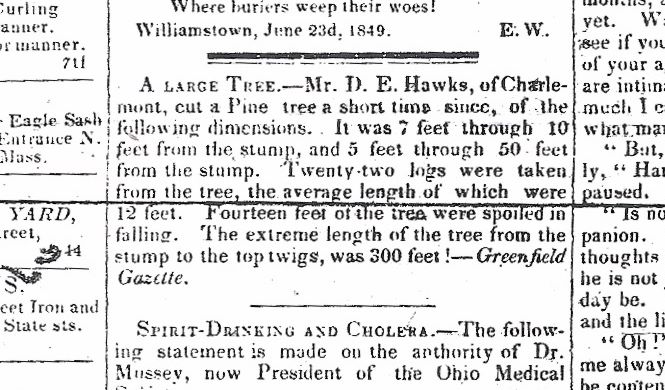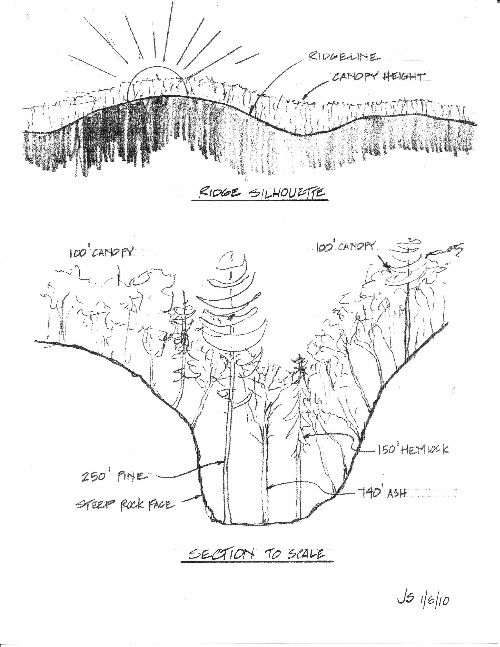ENTS,
Recently we have had some discussions
regarding reports of white pines in New
England reaching heights of 250 feet, and
one case of 300 feet. These have been spread
out over a half dozen topics and much
discussion about whether or not these
heights were possible. What I want to do
here is to simply compile a listing of these
accounts and their sources. I do not want
this Thread to be a discussion of whether
they existed or not - It should simply be a
compilation of these reports. If you have
copies of any of these accounts please add
them to the thread. I have included excerpts
from GREAT EASTERN TREES, PAST AND PRESENT
by Colby B. Rucker, from the Bulletin of The
Eastern native Tree Society, Volume 3, Issue
4 7 Fall 2008. I also have
included to start a copy of a post by Time
Zelazo - I am not sure of the source or
date, and some general background
information from Jack Sobon - beyond this I
just want to compile the historical accounts
and not have an extended discussion of their
validity.
Edward Frank
Western Pennsylvania
--------------------------------------------------------------------------------
GREAT EASTERN TREES, PAST AND PRESENT by
Colby B. Rucker, from the Bulletin of The
Eastern native Tree Society, Volume 3, Issue
4 7 Fall 2008
New Hampshire: Eastern White Pine. A pine
cut long ago on the site of Dartmouth
College was said to have been 240' tall.
Although many doubt the species is capable
of attaining such a height, the legend has
persisted. Reference: Lane, Ferdinand C.,
1953. The Story of Trees, pp. 67-68.
New York: Eastern White Pine, It is said
that a fallen specimen at Meridith, New York
measured 247 feet in length. Reference:
American Forests, Spring 2000, p. 38.
Comments: No other details are available. No
authenticated records indicate that such
heights were actually attained.
Pennsylvania: Eastern White Pine. Girth
37 feet, height 200 feet. "Felled near Cedar
Run." Reference: Lane, Ferdinand C., 1953.
The Story of Trees, p.67. Comments: Lane
gives no other details. The girth seems
excessive, even at grade.
Wisconsin: Eastern white pine. A white
pine felled near the Flambeau River, in
northwest Wisconsin yielded 14 logs that
scaled 22,620 board feet. Reference: Stevens
Point Journal, 2/26/1898. (courtesy of Paul
Jost, 2/16/2004).
Eastern white pine. A white pine near the
Plover River, in the Hatley area of Marathon
County, was reported to have a circumference
of 19' 6", and a height of nearly 200 feet.
Reference: S. A. Sherman, pioneer
lumberman, 1884. (courtesy of Paul Yost,
2/16/2004).
Eastern white pine. A white pine to be
cut on the land of Mr. Wadleigh, near Hatley,
Marathon County, was said to be the largest
in Wisconsin. It was 27 feet in
circumference. Reference: Stevens Point
Journal, 12/1/1883. (courtesy of Paul Yost,
2/16/2004).
--------------------------------------------------------------------------------
Tim Zelazo posted on December 15, 2009:
This is just an old article for Ed so
please don't take it as the truth.
The article above talks about a burial
June 23, 1849.
--------------------------------------------------------------------------------
Jack Sobon, January 5, 2010
Dear Gaines,
Thanks for keeping the White pine height
debate alive. I read the white pine info at
the link you referenced but didn't glean the
same information that you did. First off,
nowhere was there indicated a maximum height
potential, regardless of site index.
Second, the charts showing growth
increments are for sites in the Southern
Appalachians, the Southern extreme of White
pine's range. The historic reports of 250+
trees are all in New England, at the center
of its range. Third, site index does not
take into account the micro climate and
topography. We've all seen those damp,
sheltered hollows and ravines where
nutrients collect, the ground stays wet all
through the growing season, and mosses cover
everything, where trees are protected from
wind and are substantially taller and
healthier than those outside the area though
of similar age. That's where the tallest
trees are now and would have been
historically. Not a lot of trees in the
250' class, just a handful scattered across
the Northeast but certainly
thousands of trees over 180' (our current
Northeast tallest pine).
Also, according to that chart, the height
difference between trees growing on the
poorest sites to those on the best is 60
feet, not 20.
As for annual growth after 55 years being
about a foot, I've felled trees in the
55-80 year old class where I've measured the
annual height growth for the last three
years over 30" per year. A chart for the
Southern Appalachians won't necessarily
apply to New England.
Though the account of a 300 foot pine in
Charlemont, Massachusetts may be stretched,
surely some of the other 250'+ accounts must
be true. They had accurate measuring
devices then. Though they lacked the
techno-gizmo's of today, they were not
primitive. There were surveyors, builders,
and others skilled in measuring then. When
I measure old structures from the 1700's,
they are typically within a quarter inch on
a sixty foot length. A modern steel
measuring tape can vary that much from
winter to summer with thermal expansion.
Just because we don't have them today,
doesn't mean there weren't 250 footers then.
Nowhere in New England are there now pines
growing in an ideal spot (like that I
mentioned above) where they have been
undisturbed for 400 years!
Jack Sobon
--------------------------------------------------------------------------------
Silvics of North America, United States
Department of Agriculture, Forest Service,
Agriculture Handbook 654G. W. Wendel and H.
Clay Smith
Eastern white pine (Pinus strobus), also
called northern white pine, is one of the
most valuable trees in eastern North
America. Before the arrival of white men,
virgin stands contained an estimated 3.4
billion m³ (600 billion fbm) of lumber. By
the late 1800's most of those vast stands
had been logged. Because it is among the
more rapid growing northern forest conifers,
it is an excellent tree for reforestation
projects, landscaping, and Christmas trees
and has the distinction of having been one
of the more widely planted American trees.
Growth and Yield- White pine is a
long-lived tree commonly reaching 200 years
if undisturbed; maximum age may exceed 450
years. It has a remarkable rate of growth
compared to other pine and hardwood species
within its range (20). Trees 102 cm (40 in)
in d.b.h. and 46 m (150 ft) tall were common
in the virgin forests of Pennsylvania,
Michigan, and New England (71). In the
"National Register of Big Trees" (54), there
are two champion white pines: one in
Michigan is 168 cm (66 in) in diameter and
48.2 m (158 ft) tall, and the other in Maine
is 173 cm (68 in) in diameter and 44.8 m
(147 ft) tall.
--------------------------------------------------------------------------------
From: JACK SOBON
Date: Wed, 6 Jan 2010 12:08:26 -0800 (PST)
Subject: Re: [ENTS] Re: White pine growth
rates--something of interest about growth
possibilities
Dear Gaines, Ed Frank, Bob, ENTS,
I would be highly suspect of historical
white pine height measurements of standing
trees, but I believe all the reports are of
felled specimens. As for measuring felled
trees, I have dropped thousands of white
pine in the 80-120' range and measured a few
hundred. The trunk occasionally fractures
at upper branch whorls and the top 3 or 4
feet might have to be looked for nearby but
the tree's trunk is still intact and easy to
measure after limbing. I think that if
someone wanted bragging rights to an
exceptional tree, they probably had it
verified.
The other stumbling block to this maximum
height issue seems to be the exposure and
canopy height issue. Most of you are
envisioning a typical forest canopy on
gently rolling ground. In such forests, I
doubt the trees would have reached 200 feet.
However, in a rugged landscape there are
occasional pockets where trees can be much
taller without being unduly exposed. In
these rare cases, a pine could reach 250
feet and still be protected. I attach a
sketch illustrating my point. The top
drawing shows a forested ridge with the sun
behind it. As you will see, the canopy
height is not parallel with the ridge but
tends to even out the profile. It is
shorter at peaks and higher in hollows.
Check this out for yourself at sunrise or
sunset. It is easier this time of year with
the leaves off and the sun so low. The
lower drawing shows how a single 250 foot
pine growing in a ravine can be way above
other trees and still not be too exposed.
The moist, fertile environment and quest
for sun would encourage such growth. This
would be a rare condition of course hence
the relatively few historical reports of
such trees. To my knowledge, none of the
tallest pines measured recently (MA 169', CT
172', PA 182', NC 207') are growing in such
a protected site and none are of the
diameters of the historic examples. For
instance, the Charlemont, MA pine felled in
1849 was seven feet in diameter 10' from the
stump and 5' diameter 50' from the stump.
Our tallest pine today has a 44" DBH!
Every one is looking for reasons why it
couldn't be true instead of how it might be
true. Is 250' really that far-fetched?
Where are the optimists?
Jack Sobon
--------------------------------------------------------------------------------

|
dy+be+VfI.jpg
108K |
|

|
|
250'+Pine1.jpg
75K |